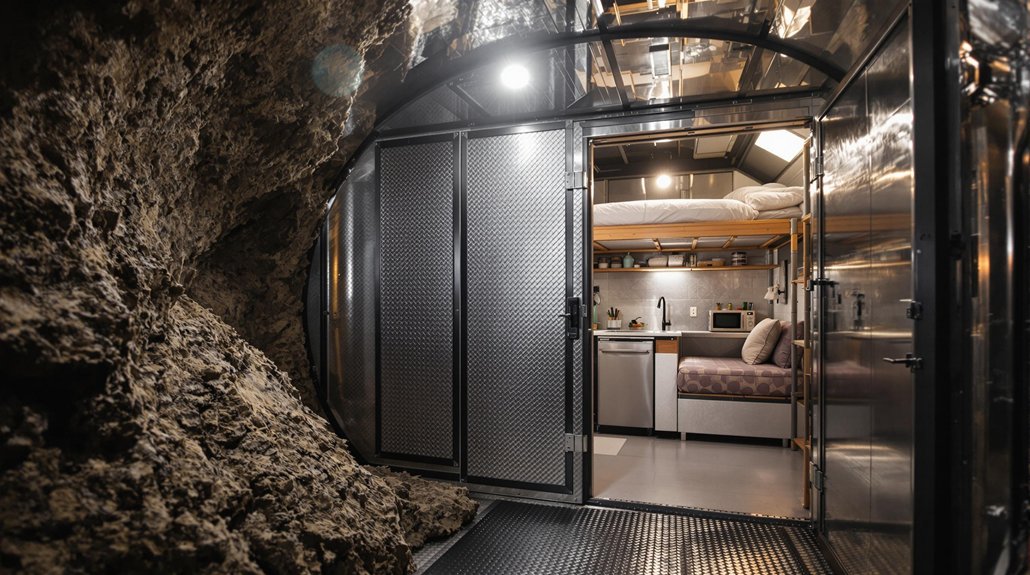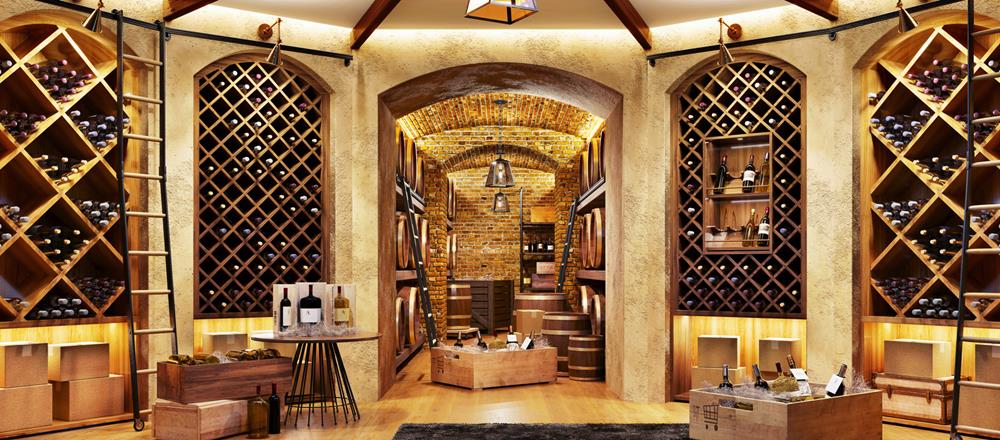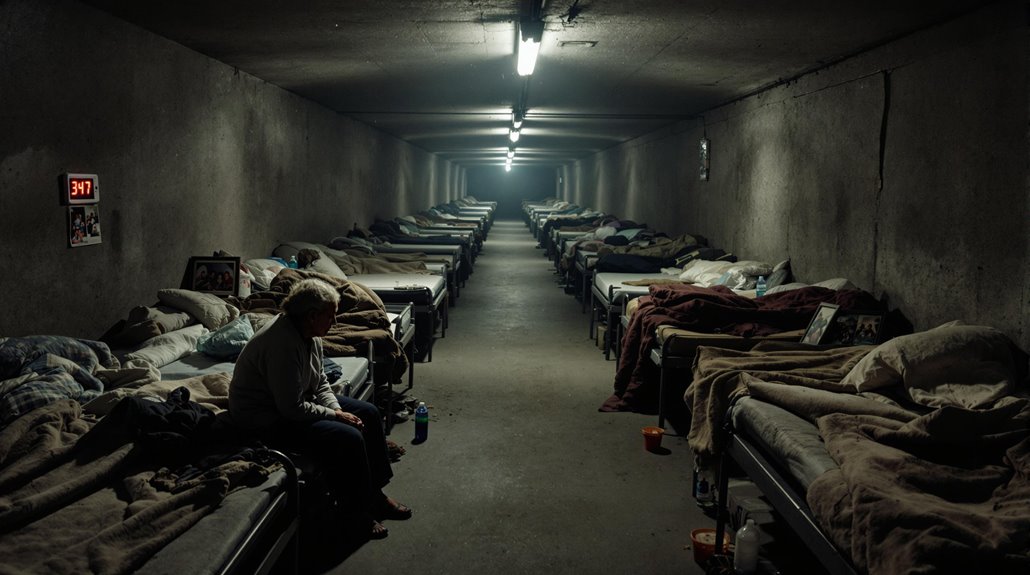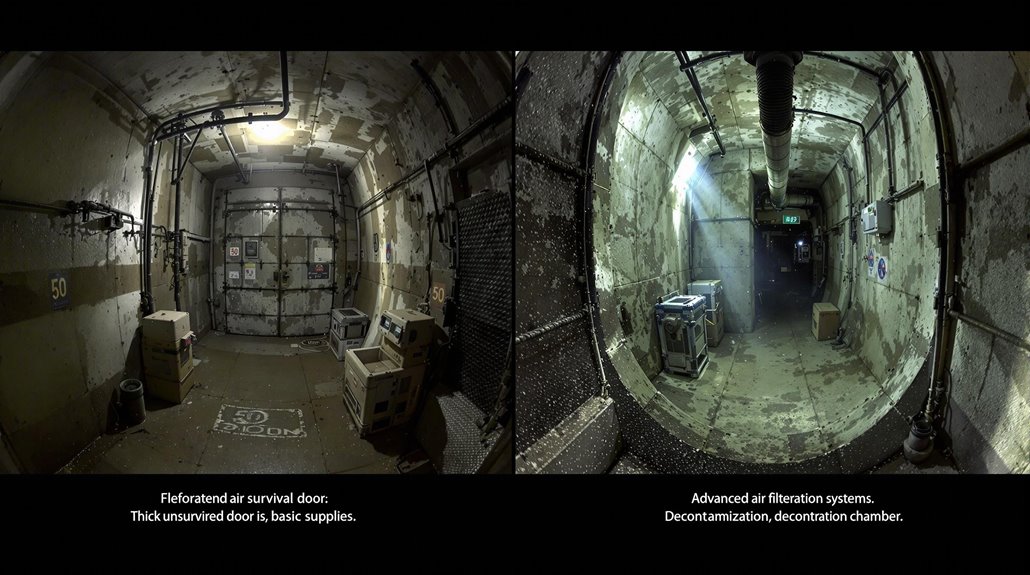Are Bomb Shelters Actually Effective?
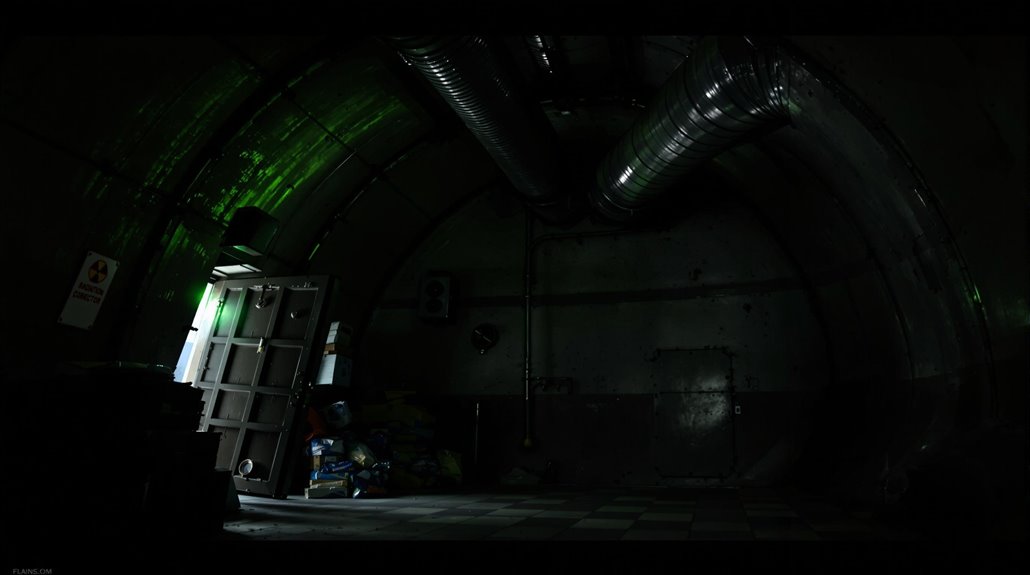
Yes, bomb shelters are highly effective when properly engineered. You'll find strong protection in dedicated blast shelters built with steel-reinforced concrete and specialized blast doors, capable of withstanding nuclear detonations up to 500 kilotons at 500 meters. While basement shelters offer limited safety, purpose-built bunkers shield you from thermal radiation, blast waves, and fallout through advanced ventilation and filtration systems. Understanding the specific features and limitations will determine your survival chances.
The Science Behind Blast Protection
When it comes to protecting against explosive forces, blast shelters rely on sophisticated engineering principles that make the difference between life and death. You'll find these shelters built with steel-reinforced concrete in vault or arch designs, specifically engineered to withstand nuclear blast pressures up to 500 kilotons at 500 meters.
The shelter's effectiveness depends on pivotal design elements: countersunk blast doors that won't lift during impact, and ventilation systems you can operate manually to prevent overheating. While underground shelters shield you from immediate thermal and direct radiation, you're still facing two major threats - the blast wave and radioactive fallout.
That's why proper construction is indispensable. Every component, from the walls to the doors, must work together to create an all-encompassing defense system that'll protect you when you need it most. Modern bunkers now incorporate advanced air filtration systems that continuously monitor and adapt to changes in air quality, providing an essential first line of defense against external contaminants.
Types and Classifications of Shelter Designs
While all bomb shelters serve the fundamental purpose of protection, they fall into distinct categories based on their design and intended use. You'll find two main types: dedicated blast shelters specifically engineered for nuclear warfare protection, and dual-purpose structures that combine everyday functionality with blast-resistant features.
Dedicated blast shelters typically feature steel-reinforced concrete construction designed to withstand the intense blast wave from a nuclear attack. They're equipped with specialized blast doors, often in pairs, that match the walls' strength. In contrast, dual-purpose shelters might include reinforced basements, tunnels, or other civil engineering structures adapted for protection.
Both types require sturdy air filtration and ventilation systems, like manual air pumps, to maintain breathable conditions and prevent overheating during extended shelter periods. During the Cold War era, many of these facilities were strategically designed as civil defense strategy installations to protect civilian populations from nuclear threats.
Critical Design Elements and Specifications
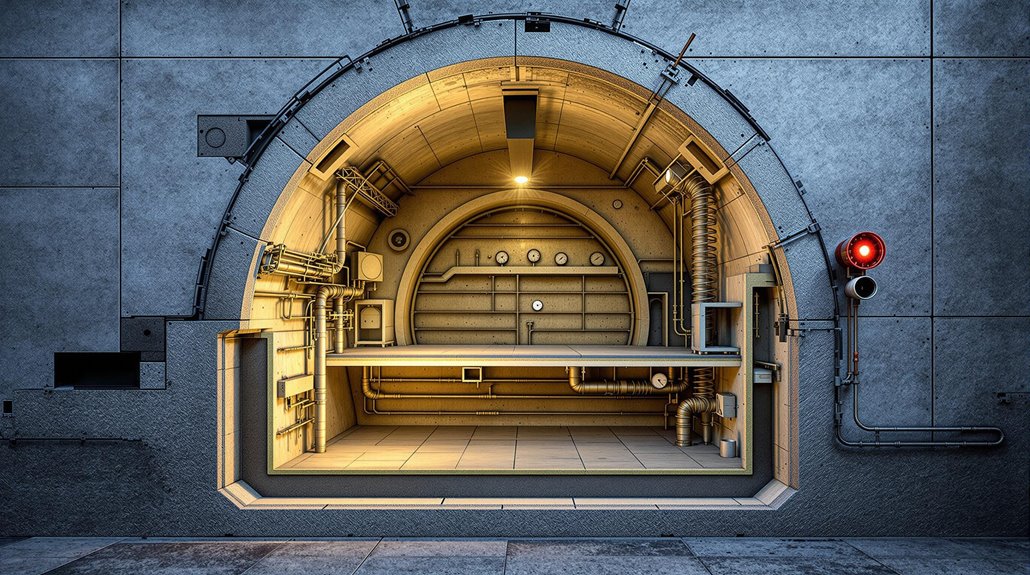
The core specifications of an effective bomb shelter revolve around precise engineering calculations and sturdy construction methods. You'll need steel-reinforced concrete vaults or arches capable of withstanding massive overpressures from nuclear detonations at specific distances.
Your shelter's blast doors must match the strength of its walls, featuring countersunk edges and trap-door designs to prevent failure under extreme pressure. Proper ventilation systems with blast valves are essential to prevent heat prostration and maintain air quality. You'll also need extensive radiation shielding, which requires careful placement at least 6.2 km from potential detonation sites.
Don't overlook weatherproofing - it's indispensable to incorporate plastic film and sprung internal structures to protect against ground shock and normal weather conditions while maintaining the shelter's structural integrity. Modern residential bunkers often utilize fiber-reinforced plastic shells for superior structural strength while maximizing available space.
Ventilation and Life Support Systems
Survival in a blast shelter depends heavily on maintaining proper air circulation and breathable conditions. When you're in a confined underground space, you'll need sturdy ventilation systems to prevent heat exhaustion and maintain oxygen levels. While fallout shelter signs might mark the entrance, what's inside matters most for survival.
Your blast shelter's ventilation system needs to incorporate blast valves to protect against initial shock waves. In urban areas, you'll want additional features like water cooling or breathing tubes to guard against fire risks. Since power might be unreliable during a nuclear attack, manually operated systems are indispensable.
An Air Pump offers a simple but effective solution for air circulation when electrical systems fail. This hand-operated fan design guarantees you'll have fresh air even without power. An NBC filtration system is essential for removing harmful contaminants and ensuring long-term air quality in your shelter.
Location and Accessibility Factors

Beyond having proper ventilation, your shelter's location can mean the difference between life and death. If you're planning to seek shelter during a nuclear blast, you'll need to consider that two-thirds of existing shelters are dangerously close to potential strike zones. These locations offer minimal protection against nuclear fallout, as occupants could face lethal conditions during a direct hit.
- Most shelters near strike targets won't protect you from being "barbequed"
- Escaping radioactive fallout zones requires specialized equipment rarely available to civilians
- Basement shelters lack essential supplies and proper ventilation systems
- You must reach your shelter before detonation to avoid thermal radiation exposure
- Alternative locations like interior rooms provide limited protection compared to purpose-built shelters
The accessibility of your shelter is essential - you'll need a clear, quick path to safety that doesn't cross through high-risk areas.
Blast Door Engineering and Security
Proper blast door engineering stands as your shelter's most critical line of defense against nuclear detonation forces. To be effective, your blast doors must match the strength of your shelter walls, ensuring complete protection from extreme pressures. You'll find that trap-door designs offer a cost-effective solution while maintaining maximum security.
The design details matter greatly. Your blast doors should feature countersunk edges to prevent the blast wave from compromising the door's integrity. For added safety, many blast shelters incorporate two separate doors, providing you with an alternate escape route if debris blocks your primary exit. Smart engineering solutions include combining door shafts with ventilation shafts, which reduces construction complexity while maintaining the shelter's protective capabilities.
Survival Duration and Supply Requirements

When planning for extended shelter stays, you'll need to stock enough supplies to sustain life for at least two weeks - the critical period during which radiation levels typically decrease to safer levels. Most dedicated fallout shelters come equipped to handle this duration, but improvised spaces like basements might leave you vulnerable without proper preparation.
Key survival requirements after a nuclear explosion include:
- A reliable ventilation system that can function during power outages
- Enough food and water for all occupants, calculated per person per day
- Essential medical supplies and first-aid equipment
- Waste management and sanitation solutions
- Air filtration systems to prevent radiation exposure
Remember that shelter space beyond two weeks becomes increasingly dangerous due to carbon dioxide buildup, disease risks, and resource depletion. Your survival chances depend heavily on proper supply planning and shelter management.
Thermal and Radiation Shielding Capabilities
The effectiveness of a bomb shelter's protective capabilities hinges primarily on its shielding against thermal and ionizing radiation. When properly built, your shelter can reduce exposure from a nuclear blast by up to 1000 times, protecting you from lethal radiation doses within 2.3 km of the nuclear device and significant hazards up to 2.9 km away.
While you'll be well-protected from thermal radiation and direct ionizing radiation during the initial blast, your shelter's defense against radioactive fallout is more limited. However, fallout radiation decreases rapidly - you'll see a 70-80% reduction within 10-20 days. If no additional attacks occur, you could potentially evacuate the highly radioactive zone within 100 days. Remember that your shelter's effectiveness depends on specialized equipment and precise construction, as even minor flaws can compromise its protective qualities.
Historical Performance and Case Studies

Historical evidence from the Cold War era reveals mixed results for bomb shelter effectiveness. You'll find that despite massive government investments of over $169 million in fallout shelters, their real-world protection capabilities fell short of expectations.
- Shelters within 6.2 km of a nuclear blast offered minimal protection from blast effects
- A 20-megaton bomb over NYC would have "barbequed" shelter occupants near ground zero
- Most Cold War shelters weren't adequately equipped for long-term survival
- Radiation protection varied extensively based on shelter location and construction
- Evacuation from highly radioactive zones proved nearly impossible without specialized equipment
The U.S. government's ambitious shelter program, while well-intentioned, ultimately proved unrealistic for protecting the population during nuclear war. Modern analysis shows that these shelters would've saved far fewer lives than initially projected, particularly in areas close to direct strikes.
Modern Threats and Protection Limitations
Despite technological advances in shelter construction, modern nuclear threats pose severe challenges that limit bomb shelter effectiveness. You'll find that even well-constructed shelters can't guarantee protection against today's high-yield nuclear weapons, which can create devastating firestorms and deep craters in urban areas.
While the federal government promoted shelter programs in public buildings, their limitations became apparent even before implementation. You should know that radiation safety measures may prove insufficient when shelters are too close to blast zones, where occupants could face lethal conditions. The reality is that nuclear attacks on military targets could easily affect civilian areas, and current shelter systems offer only basic protection rather than assured survival. This gap between perceived and actual effectiveness continues to challenge modern civil defense planning.

